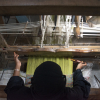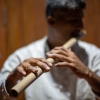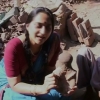Part 1: Prabhat’s production system
Anil Damle: V.G. Damle learned the art of painting backdrops from Anandrao Painter (brother of the sculptor, painter, filmmaker Baburao Painter). These backdrops were used in theatre. There he understood the art of creating 'atmosphere or setting'. He furthered this training to create sets for Prabhat films. At Baburao Painter's Maharashtra Film Company, (1917–1930, hereafter MFC) he acquired knowledge of the different stages of film production. At MFC, he handled the camera as well as art direction. He had to learn everything from scratch. It was his inquisitive nature that made him constantly learn, wherever he was. On the sets of Prabhat, he acquired the tools to do sound recording. He used the trial and error method to do so. He learned on the go. Baby Shakuntala (a child actress from Prabhat ) once told me her memory of him moving around in the studio with the recording device to get the right pitch. This is how he understood recording.
Prabhat was in Kolhapur from 1929 till 1934. Thereafter the studio moved to Pune. Damle was involved in the construction of the studio since he understood the craft of films as well as of architectural requirements. He had a grasp of the technological developments in the area of filmmaking and his foresight went into the actualisation of the studio. The Studio No. 1 (now in FTII) is grand. It is not just a big studio, but there is a realisation of indoor and outdoor shooting spaces. For example, the vision of using water sources to create the setting of a pond inside the studio helped in controlling the light in an indoor setting. The height of the studio helped in drawing lights from a distance. There were walkways all around. The crew could move around spaces connected seamlessly through the walkways. The artists could easily come from the adjoining makeup rooms. The location of the studio near a hill meant that the natural environment around the studio could be made a part of the shooting. The logic of concealed wiring of the studio was used to hide the camera wiring while shooting sequences of forests. He (Damle) had developed particular location spots in the nautral settings around the studio. For instance, he made lakes and ponds to give a feel of authentic natural settings. The ghats of sea used in certain films were shot at the swimming pool in the environs of the studio.
The everyday working of the studio involved intricate connections between the work spaces. The music rooms were soundproof. Prabhat was one of the first studios to have an air-conditioned film processing laboratory since films was shot on nitrate, and dust or dirt would have ruined the celluloid material. A closed space would have become claustrophobic to work in for such long hours.
Prabhat was established as a collective by V. Shantaram (direction), S. Fattelal (art direction), Dhaiber (camera) and Damle (art direction, camera, sound). As the film company expanded, newer technical experts were required. Some positions were given to the relatives of these four key members. A second league was created. The studio was run like a family business. Those days the studio was the most important institution in filmmaking. Actors, crew members were on the pay roll of the studio. Slowly, attitudes changed and the hero-based star system came about. The studio system started breaking down. Obviously, studios breaking up was not a new thing at all. Even when Fattelal and Damle were in Baburao Painter's MFC, outside technicians were brought in and they left the company because they were hurt. Similarly, when name and fame increased there was a move towards calling big actors from Bombay-based studios. These were the reasons for the cracks developing in the studio system. I think the factor that altered the fate of the studio was that people coming from outside did not have the same aesthetic, social concerns and inclinations. Though those inclinations were not necessarily incorrect.Another factor was the amount of time spent on working on the film, rehearsals and casting. Later, it became a hurried affair. It was finished quickly like a job.
In 1941, V. Shantaram left the studio. Damle could not recover from it. Conflicts emerged. Damle was bedridden. The company lost its sheen. In 1955, the company was liquidated since Baburao Pai (a later partner in the studio) and others were not administrative anchors. If you see the careers of other studios of the same period, they also had a similar fate.
During the making of Lakharani (1945), the studio lost a lot of money and income tax issues erupted. The cycle of money inflow, outflow and profits did not work. There was a discord in the environment of the studio. I remember my grandmother telling me about how people tried to make money out of the studio which was then crumbling down. Many members of the studio lost their credibility and their careers were over. Everyone tried taking the space of administrative authority.
Part 2: Prabhat to FTII
A.D.: After the studio got liquidated in 1955, Bombay's Kelkar Attarwale (perfume makers) took over. Kelkar was a businessman and he tried to run the Studio like a business but it never really worked out. He rented out the studio on a few occasions. Sangtye Aika, Didi, Gaj Gauri, Romeo and Juliet were shot in Prabhat. He was not a filmmaker so Kelkar offered the land to the central government when the government decided to start a national film school according its mandate in 1961. Earlier, it was just Film Institute of India but later the television wing was added to it. I am very proud that my grandfather's dream of starting a film institute was finally actualised, even though it happened after Prabhat. All other big studios were torn down and lapsed into anonymity but Prabhat lives through FTII.
Dev Anand, Guru Dutt, Sapru, Husnalal Bhagatram all of them started in Prabhat. We bonded like a family and have happy memories about these people. For years, they reminisced about the work culture in Prabhat since they did not see it anywhere else in the industry later on. Rehman, the famous actor, met my brother Ajit at an event. He kept talking about his Prabhat days throughout the entire event. These stars yearned for the early lessons in work culture that they had gotten at Prabhat. They might not have been able to always get good work and maintain the legacy, yet the affection they had for Prabhat was somewhere always there. In the changing environment, the values inculcated here could not have been continued.
Hrishikesh Arvikar: What happened to the films after liquidation ?
A.D.: After liquidation, whatever was involved was sold off. The same thing happened with the films. The prints went with to Mudaliar, a collector from Madras who was not directly related to films as such. And the company had shut down and Namade (assistant of Kelkar Attarwale) had other prints which he showed in theatres. For instance they showed Sant Tukaram and Sant Dnyaneshwar. The celluloid prints were ruined and we could not afford to get new prints made. They went missing completely for a period for eight to ten years. My sister Alka insisted that we try to get the films back. So my family members inquired and found out that the prints were with Mudaliar. Dada Damle (my father) and V.G. Namade (of Ulka films) were nervous about meeting Mudaliar as they did not know how much it would cost them to get the films back. Mudaliar learned about our family and the studio and he was very happy that the films were going back to those who had made them. He asked only for around 40,000 for all the 40-45 films. All the negatives were brought back to Pune. We did revised editing here in this house. Rajput, who teaches at FTII and had worked at Prabhat earlier remembered every single detail of every single film. While doing the revisions, if he had questions he would ask my father or Bapu Watve (Assistant Director at Prabhat and writer of Ek Hoti Prabhatnagari). The negatives and sound track were separate. So he brought them together. Some reels of the negative had gotten glued together and some ruined. He fixed them. The reels were then given to NFAI. I remember that V. Shantaram invited my father to Rajkamal Kalamandir (Shantaram’s own studio) where all the post-processing was done. Soon positives were made. And then you know the rest: video cassettes were made and then VCDs and DVDs.
Part 3: Afterlife of Prabhat: Property, burden or legacy
A.D.: We keep wondering whether will we be able to make a film. It is a question of ability. We don’t feel burdened but we think that the legacy of Prabhat should not be tainted. In these rapidly changing times, whether we can make a film which carries the same weight as a Prabhat film, and yet be a contemporary film, that is something that I am worried about. The issue of money has to be kept in mind as well. We hope it happens. We had made a couple of documentaries. Both It’s Prabhat and Damle Mama received National Awards. We have been attached to Prabhat’s name so we want to continue this legacy of contributing to society by making films. Regarding the material we have (books, song booklets, posters, studio correspondence), many researchers come to us and tell us that we cannot find such material all in one place. The other big studios like Raj Kapoor or Dev Anand or Rajkamal etc. have material in lying dispersed in various places. We have started scanning all the material. Documents and photographs are being digitised so that the next generations can understand what this legacy meant.
H.A.: Do you think the change in technologies has altered films in some way?
A.D.: Technically, I think it was only when the films were brought back from Mudaliar that some of them were ruined and nothing could been done about the hissing noise in scene or torn celluloid. It is only over time, I think, that such a ‘loss’ that one refers to could have happened. The films were not preserved. My father when he went to collect the films from Mudaliar saw that the films were just dumped in a godown. I remember when the film cans were opened, the entire room was full of the smell of nitrate. We have preserved whatever we could. New technologies have helped us eliminate the hissing sound in the older glass audio records. Listening to those records now, one can actually thank modern inventions, since the audio seems like it was recorded just yesterday.
Part 4: Factual history, memories or myths
A.D.: My grandmother, who had seen everything happening in front of her eyes, was alive when we had begun to conceive the book (Ek Hoti Prabhat Nagari). The author of the book, Bapu Watve, had grown up in Prabhat. He was about 10-12 years old when he came in contact with the studio and its personnel. He was close to my grandfather and had heard a lot stories from him. A lot of actors from that period were still alive. In 1979, when we celebrated 50 years of Prabhat, V. Shantaram, Gajanan Jagirdar, Kaka Bhagwat (actors), V. Avadhoot (cousin of Shantaram and Prabhat cameraman), Sudhir Phadke (music director) were alive. So my father, Watve and other family members referred to a lot of other books, accounts and material. I would say most of the writing is factual.
H.A.: Were there any articles that disturbed you or your family since family history is almost entwined with the studio history?
A.D.: Yes, particularly in the case of Shantaram’s autobiography. There were bits which were painful to read. My father had been helped by Shantaram while getting the prints processed but he thought it best to not get involved in a ‘he said-she said’ encounter. Off and on there were other articles which were difficult to digest for us especially things which misled the readers. Then again one wonders how much one can try to guard an image. My father, grandfather and grandmother, who were important links to this world are not alive anymore. Every month, my grandmother had at least 10-15 people coming to meet her. Some of them from Kolhapur, some who had worked at Prabhat.
H.A.: Every partner went in a different direction. It was inevitable. As the next generations followed, do you feel the ties are not that strong anymore?
A.D.: Well, the Fattelal family stays in front of us. We do not have that many occasions or reasons to meet each other. But yes, when we do meet the relationship is cordial. The Kulkarni family stays here as well. Dhaiber’s nephew meets us often. But there is nothing common that binds us. We have a good rapport with the Shantaram family. Kiran Shantaram (Shantaram’s son) and Madhura Jasraj (his daughter) often meet us and revive memories of older days.
Part 5: Prabhat Talkies: 1934–Present
H.A.: Prabhat Talkies, constructed in 1934, seems like a heritage site. The partnership has changed over the years. Do you think that in the everchanging cityscape of Pune, Prabhat Talkies should be kept as a heritage site and special efforts should be taken to preserve it ?
A.D.: In economic terms, Prabhat Talkies and Prabhat Film Company were two different entities. Sardar Kibe from Indore had given the lease for the theatre. The ownership belongs to the Kibe family. Pai (the family of the distributor and later Prabhat partner ) and Damle family had run the cinema hall. The original 80-years' lease is over now. They want to renew and keep the theatre going but I don’t really know what is going to happen.
H.A.: Do you think that government should do something to preserve this site of cinema?
A.D.: The norms of preservation of a heritage site might not necessarily allow for such a preservation of Prabhat Talkies. It is dear to our hearts but the norms might be different from what one wants. More importantly, in preserving a place one has to actually preserve the activity that went on there. Marathi cinema and the ethos around Prabhat Talkies should be preserved. There is a concentration of Marathi speaking people around Prabhat. When Marathi filmmakers released their films in Prabhat Talkies, in some ways it guaranteed them some success with the audiences. Whether in this current form or after some redevelopment, the activity of filmgoing should go on. And I hope that the place should be preserved in people’s hearts and in our culture rather than in the form of a building.












